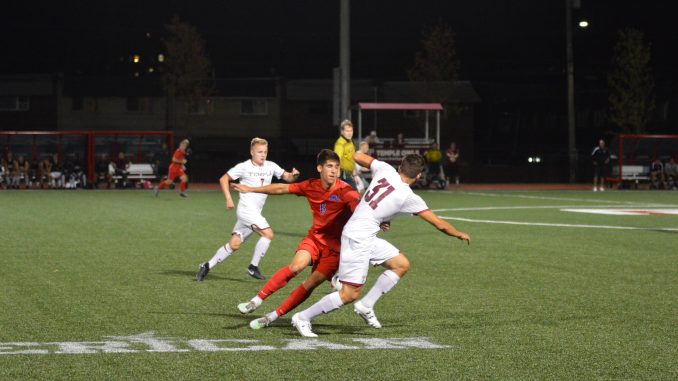
Coach David MacWilliams and assistant coach James Gledhill sat down in an old oyster house for lunch in Nantes, France.
They were meeting with Thibault Candia, then a prospective recruit, and his mother and brother.
“It was brilliant,” Gledhill said. “It was almost as if we were old friends hanging out.”
The group chatted about everything, including Temple’s soccer program, as the coaches tried to sell Candia on joining the Owls. Thanks to the visit, Candia was convinced.
Candia, a sophomore forward, is one of 10 international athletes on Temple’s 31-man roster. Temple has athletes from Spain, Germany, Scotland, Canada, France, Finland, Trinidad and Iceland. The coaches carefully scouted each player.
The coaches use their connections to find international recruits and attend showcases where up to 100 players display their skills, Gledhill said.
“You’ve got to make sure that you’ve already reached out to the handlers and you’ve already selected, kind of hand-picked, the best players,” Gledhill said. “The first thing that we ever look for in a player is definitely talent.”
The Owls’ international recruits have been successful. In 2015 and 2016, Spanish forward Jorge Gomez Sanchez led the team in scoring with 27 goals combined. This season, three of Temple’s top four scorers are international athletes. Candia leads with five goals. Finnish senior midfielder and forward Joonas Jokinen and German junior midfielder Hermann Doerner scored in Temple’s 2-1 win against Cincinnati on Saturday.
Footballers abroad often compete against players who are very experienced in the sport, which helps their development. International athletes also often play for club teams unaffiliated with their high schools, said Darri Sigthorsson, a freshman defender from Reykjavík, Iceland.
Players like Sigthorsson, Doerner and Trinidadian senior defensive midfielder Brendon Creed have even played for their national developmental teams.
“We have played with adult teams, with professionals,” Sigthorsson said. “So we have the experience from playing with the guys that have been in the sport for maybe 20 years.”
Gledhill said one reason Temple nabs international talent is because there is an abundance of professional teams overseas. Despite the United States being larger than England both geographically and in population, it doesn’t have as many academy teams for young talent to develop their skills with, he added.
Candia, who played for League 1 French Club Angers SCO, said playing for the academy teams becomes more of a job because sports and academics aren’t mixed like in the U.S.
After they get to Main Campus, international players need time to adapt to the style of soccer in the U.S., Gledhill said.
Sigthorsson and Candia each said some differences include not playing the golden goal rule — sudden death overtime — and counting down to zero at the end of each half instead of counting up to 45 minutes, and then 90.
The college game is also more “high tempo” and “not as casual” as the European style, Gledhill said. When Sigthorsson played in Iceland, his teams were limited to three substitutions per game and players who were subbed out couldn’t return. In college soccer, subs can come in and out as often as the coach wishes. Despite these differences, Gledhill said European players integrate successfully with the U.S.’s style of play.
Temple only had one international player on its roster in 2013, and he didn’t score. From 2014-16, international players scored 70.1 percent of Temple’s goals. They accounted for 20 of the team’s 23 goals in 2016, with Gomez Sanchez scoring 14 himself.
Gledhill sees a lot of value in having international athletes because it brings diversity on and off the field. Still, despite the seemingly increased interest in attracting players from overseas, the coaching staff simply wants to build the best possible team.
“For us, it doesn’t matter where you’re from,” Gledhill said. “Pennsylvania, California, Canada, Africa, Europe, it doesn’t really matter. The recruiting process is still the same. You’re trying to find the best player, the best fit for your team.”


Be the first to comment